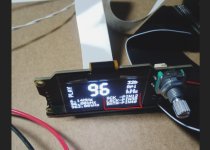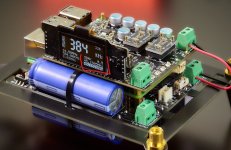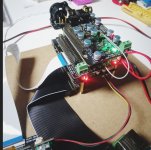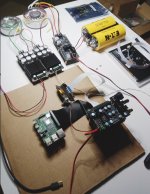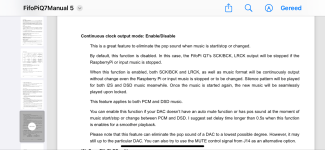Hello Terry,
I am just an expert in metal chassis construction and know nothing about 3D printing.
If i picture your chassis as a box with two rectangular holes in the bottom you will kind of construct another box like item that will contain the two caps? You will attach the two caps to the bottom of that box and then place that box upside down in the first box and part of the two caps will enter the two rectangular holes and these two parts will be protected by the extra plate.
Of course with 3 D printing the two boxes can be printed as a " single item" Of course you have to take care that things can still be accessible for mounting without the need for special tools.
Greetings Eduard
I am just an expert in metal chassis construction and know nothing about 3D printing.
If i picture your chassis as a box with two rectangular holes in the bottom you will kind of construct another box like item that will contain the two caps? You will attach the two caps to the bottom of that box and then place that box upside down in the first box and part of the two caps will enter the two rectangular holes and these two parts will be protected by the extra plate.
Of course with 3 D printing the two boxes can be printed as a " single item" Of course you have to take care that things can still be accessible for mounting without the need for special tools.
Greetings Eduard
Happy New Year to everyone on the DIY audio forum! I hope you all have a fantastic 2024 filled with successful projects and exciting new builds. I'm certainly planning to kick off the year by joining the group buy opportunity.
@iancanada Now, I have to admit that I'm one of those newcomers with a bunch of noob questions (sorry for that! ). I'm interested in building the DAC, but I also want the flexibility to use the clocks via I2S to experiment with other DACs. Do I need to build a separate DDC streamer for this purpose? I hope I don't! I plan to run this with a Mac mini or a MacBook Pro and but a friend pointed out that I could be better just using a rpie as a Roon endpoint.
). I'm interested in building the DAC, but I also want the flexibility to use the clocks via I2S to experiment with other DACs. Do I need to build a separate DDC streamer for this purpose? I hope I don't! I plan to run this with a Mac mini or a MacBook Pro and but a friend pointed out that I could be better just using a rpie as a Roon endpoint.
So far, here's my list of items. Is there anything essential that I might be overlooking? I value your input, as many of you have far more experience than I do, and I understand that Ian is likely very busy with the group buy.
Cheers, Jon
LIST so far:
@iancanada Now, I have to admit that I'm one of those newcomers with a bunch of noob questions (sorry for that!
 ). I'm interested in building the DAC, but I also want the flexibility to use the clocks via I2S to experiment with other DACs. Do I need to build a separate DDC streamer for this purpose? I hope I don't! I plan to run this with a Mac mini or a MacBook Pro and but a friend pointed out that I could be better just using a rpie as a Roon endpoint.
). I'm interested in building the DAC, but I also want the flexibility to use the clocks via I2S to experiment with other DACs. Do I need to build a separate DDC streamer for this purpose? I hope I don't! I plan to run this with a Mac mini or a MacBook Pro and but a friend pointed out that I could be better just using a rpie as a Roon endpoint.So far, here's my list of items. Is there anything essential that I might be overlooking? I value your input, as many of you have far more experience than I do, and I understand that Ian is likely very busy with the group buy.
Cheers, Jon
LIST so far:
- #1D FifoPi Q7
- #4B ES9038Q2M Dual Mono II DAC
- #6B OPA861 Zero feedback balanced I/V
- #19D ReceiverPi DDC
- #35C StationPi SMT
- #49B MonitorPi Pro
- #50A GPIO extension KIT4.
- #50B GPIP spacer
- 2x#12A 13/2.5mm standoffs
- #41 UcPure MkIII (4) I'll purchase 10 EATON XL60-2R7308T-R from Mouser at a cost of $91 each when ordering 10. I'll run a quad for the SC-Pure
- #41F UcBalancer protection kit (5)
- #80A & #80B SC-Pure
Hi guys,
I've just assembled my stack and got an issue with the StationPi Pro MKII - no signal at SPDIF. To speed up: I've assembled a minimum configuration without the StationPi Pro i.e. just RPi + FifoPi Q7 + TransportPI MKII + external DAC => it works like a charm, tested with Volumio and pCorePlayer. Power supplies are just same as below, with both 3.3V and 5V connected to the FifoPi Q7.
The full stack:
As I am waiting for my Supercapacitors, I used Twisted Pear Centraur PSU to get 3.3V, and 5V from an arbitrary PSU is shared between the FifoPi and the RPi by shorting both jumpers of StationPi Pro J9. Both power supplies are connected to the FifoPi inputs. After switching on, all power LEDs are ok, but there is no sound, the i2s output LED is dark and the "empty" indicator is on.
What I've tried so far:
Or maybe where to start with debugging of the StationPi? Any ideas?
I've just assembled my stack and got an issue with the StationPi Pro MKII - no signal at SPDIF. To speed up: I've assembled a minimum configuration without the StationPi Pro i.e. just RPi + FifoPi Q7 + TransportPI MKII + external DAC => it works like a charm, tested with Volumio and pCorePlayer. Power supplies are just same as below, with both 3.3V and 5V connected to the FifoPi Q7.
The full stack:
- StationPi Pro MKIIa (this is what's written on the PCB, I believe, that's the latest iteration)
- StationPi Pro Daughter Board + RaspberryPi 2 Model B rev. 1.2 (64-bit) on top at the Pi side
- FifoPi Q7 installed along the StationPi Pro (bended last 6 pins of the transversal HAT GPIO to avoid shorting with a FifoPi's heatsink), control port is connected to the StationPi Pro with an included cable (1 and 4 pins are connected to same 1 and 4 pins)
- TransportPi MKII on top of the Q7
- External DAC connected with the S/PDIF RCA
As I am waiting for my Supercapacitors, I used Twisted Pear Centraur PSU to get 3.3V, and 5V from an arbitrary PSU is shared between the FifoPi and the RPi by shorting both jumpers of StationPi Pro J9. Both power supplies are connected to the FifoPi inputs. After switching on, all power LEDs are ok, but there is no sound, the i2s output LED is dark and the "empty" indicator is on.
What I've tried so far:
- supply 5V via J3 or via J5 of the StationPi Pro
- supply 5V separately to RPi and Audio parts (J3 and J5 respectively) with J9 jumpers both disconnected
- turn it on without the control cable connected
Or maybe where to start with debugging of the StationPi? Any ideas?
Had a similar problem not sure if it is related to yours , where the StationPiPro was not soldered correctly on a few of the pins, one of the Pins was the data, so was receiving the word clock but no data. Just re-soldered the faulty pins on the 40 pin connectors and it now works.Hi guys,
I've just assembled my stack and got an issue with the StationPi Pro MKII - no signal at SPDIF. To speed up: I've assembled a minimum configuration without the StationPi Pro i.e. just RPi + FifoPi Q7 + TransportPI MKII + external DAC => it works like a charm, tested with Volumio and pCorePlayer. Power supplies are just same as below, with both 3.3V and 5V connected to the FifoPi Q7.
The full stack:
So, basically the StationPi Pro is defaulted (pre-factory assembled).
- StationPi Pro MKIIa (this is what's written on the PCB, I believe, that's the latest iteration)
- StationPi Pro Daughter Board + RaspberryPi 2 Model B rev. 1.2 (64-bit) on top at the Pi side
- FifoPi Q7 installed along the StationPi Pro (bended last 6 pins of the transversal HAT GPIO to avoid shorting with a FifoPi's heatsink), control port is connected to the StationPi Pro with an included cable (1 and 4 pins are connected to same 1 and 4 pins)
- TransportPi MKII on top of the Q7
- External DAC connected with the S/PDIF RCA
As I am waiting for my Supercapacitors, I used Twisted Pear Centraur PSU to get 3.3V, and 5V from an arbitrary PSU is shared between the FifoPi and the RPi by shorting both jumpers of StationPi Pro J9. Both power supplies are connected to the FifoPi inputs. After switching on, all power LEDs are ok, but there is no sound, the i2s output LED is dark and the "empty" indicator is on.
What I've tried so far:
Unfortunately, nothing helped. My gut feeling says it might be something to do with the control port of the StationPi Pro, but so far I didn't find any info on that. How should it work? Should it be connected?
- supply 5V via J3 or via J5 of the StationPi Pro
- supply 5V separately to RPi and Audio parts (J3 and J5 respectively) with J9 jumpers both disconnected
- turn it on without the control cable connected
Or maybe where to start with debugging of the StationPi? Any ideas?
Hello everyone, Happy New Year!
My build is progressing... but I just have a little problem.
I have read all manuals and re-read and FIfo Pi Q7 again and again
I follow the instruction but I don't have "clock frequency" on the monitor pro. I see number of pin with the signal . no sound
my configuration is :
RPi 4 deported with gpio extender cable
Receiver Pi DDC
Fifo Pi Q7
Transport Pi AES
an my DAC is Chord DAC64 Mk2 ( 24/192Khz)
All alimentations is good and I think it's problem with signal configuration
the software is Volumio , General I2C DAC, DoP configuration
What is wrong ????
My build is progressing... but I just have a little problem.
I have read all manuals and re-read and FIfo Pi Q7 again and again
I follow the instruction but I don't have "clock frequency" on the monitor pro. I see number of pin with the signal . no sound
my configuration is :
RPi 4 deported with gpio extender cable
Receiver Pi DDC
Fifo Pi Q7
Transport Pi AES
an my DAC is Chord DAC64 Mk2 ( 24/192Khz)
All alimentations is good and I think it's problem with signal configuration
the software is Volumio , General I2C DAC, DoP configuration
What is wrong ????
Attachments
Hello,Had a similar problem not sure if it is related to yours , where the StationPiPro was not soldered correctly on a few of the pins, one of the Pins was the data, so was receiving the word clock but no data. Just re-soldered the faulty pins on the 40 pin connectors and it now works.
So it is bad or no quality control. Better pay more for boards that are actually working. If you have to reflow all the solder joints just to be sure that any issue will not be related to a bad joints i will ask a professional to make me the complete thing.
Greetings Eduard
Dear NeoTheOne;
I'm a bit concerned with the bare wires sticking out of the connectors, please shorten them or clean them up but make sure that you never ever make a short circuit by accident.
😉
H,Hello everyone, Happy New Year!
My build is progressing... but I just have a little problem.
I have read all manuals and re-read and FIfo Pi Q7 again and again
I follow the instruction but I don't have "clock frequency" on the monitor pro. I see number of pin with the signal . no sound
my configuration is :
RPi 4 deported with gpio extender cable
Receiver Pi DDC
Fifo Pi Q7
Transport Pi AES
an my DAC is Chord DAC64 Mk2 ( 24/192Khz)
All alimentations is good and I think it's problem with signal configuration
the software is Volumio , General I2C DAC, DoP configuration
What is wrong ???Hi,
you must connect the MonitorPi directly to the FiFo Pi Q7 (non isolated,dirty side), then you will see the XO frequency.
Thanks for pointing it out. I’ve put electrical tape on the all the cables near the connectors.Dear NeoTheOne;
I'm a bit concerned with the bare wires sticking out of the connectors, please shorten them or clean them up but make sure that you never ever make a short circuit by accident.
😉
To everyone out there building on the USBridge platform - how do your project look like?
Thanks for any inspiration 🙂
Thanks for any inspiration 🙂
Hi guys. Happy New Year to all.
I purchased PurePi with FifiPi Q7. I also purchased ShiedPiPro but I was wondering, and asking you, if it wasn't superfluous.
Thank you
I purchased PurePi with FifiPi Q7. I also purchased ShiedPiPro but I was wondering, and asking you, if it wasn't superfluous.
Thank you
Hi thank you 🙏H,
you must connect the MonitorPi directly to the FiFo Pi Q7 (non isolated,dirty side), then you will see the XO frequency.
I don't know why, but it works now.
I can see the frequency with the Monitor Pi Pro on the isolated GPIO port.
I get a "plop and crackle" sound when I change manualy to the next music or change to any music. If I don't touch anything, with gapless, no problem.
I read somewhere in this thread, other people have the same problem.
I can hear some relays in my dac during the changment files .
I don't know if it's Fifo Pi Q7 bad parameters or other thing somewhere...
I need to resolve this new problem
https://www.diyaudio.com/community/...ks-mods-and-hints.335881/page-96#post-7383062
This partly answers your questionI also purchased ShiedPiPro but I was wondering, and asking you, if it wasn't superfluous.
Thank you
clsidxxl, thanks although I must say I didn't understand much.
Let's hope it's better than nothing.... we will be careful of the heat
Let's hope it's better than nothing.... we will be careful of the heat
Hi thank you 🙏
I don't know why, but it works now.
I can see the frequency with the Monitor Pi Pro on the isolated GPIO port.
I get a "plop and crackle" sound when I change manualy to the next music or change to any music. If I don't touch anything, with gapless, no problem.
I read somewhere in this thread, other people have the same problem.
I can hear some relays in my dac during the changment files .
I don't know if it's Fifo Pi Q7 bad parameters or other thing somewhere...
I need to resolve this new problem
The reason is that a RPi stops the I2S/DSD signal and clock completely when the music is stopped or switch to another one.
What external DAC are you using? It seems that the DAC doesn't mute automatically during the signal switching.
There could be two options for you:
1. Using the MonitorPi Pro to enable the Q7 continuous clock mode, to see if there is any improvement.
2. Connect to your DAC using the HDMI connection, most DAC takes mute control signal from the HDMI cable.
Ian
I started a blog for Tips of DIY digital audio projects.
https://iancanada.ca/blogs/news
I'm still working on adding more.
Please let me know if you have any tips to share.
Thanks,
Ian
https://iancanada.ca/blogs/news
I'm still working on adding more.
Please let me know if you have any tips to share.
Thanks,
Ian
Thanks and a great start @iancanada - some suggestions
1. Topic on Super Caps e.g. When soldering a super cap to a PCB a soldering iron of >=80w is required, please ensure you make a suitable joint on each cap lug. Ensure always discharged and how to check that etc
2. For UcPure using Ucbalancer module mine all needed pins to be cut shorter AND to double up on the washers to ensure no risk of shorting out - IMPORTANT. Ensure that the UcPure that is installed on top of the super caps there is a physical gap to ensure no pins can penetrate and short on the super cap.
3. Ensure and inspect closely your power cable connections to the modules - I have seen many builds where potential shorts could happen and dangerous
4. I see the value for you to release PDF(s) for the module stacks you show as a picture and recommend. In these PDFs you explain how to build them and setting needed, cable connects etc. This will help new people ALOT!
1. Topic on Super Caps e.g. When soldering a super cap to a PCB a soldering iron of >=80w is required, please ensure you make a suitable joint on each cap lug. Ensure always discharged and how to check that etc
2. For UcPure using Ucbalancer module mine all needed pins to be cut shorter AND to double up on the washers to ensure no risk of shorting out - IMPORTANT. Ensure that the UcPure that is installed on top of the super caps there is a physical gap to ensure no pins can penetrate and short on the super cap.
3. Ensure and inspect closely your power cable connections to the modules - I have seen many builds where potential shorts could happen and dangerous
4. I see the value for you to release PDF(s) for the module stacks you show as a picture and recommend. In these PDFs you explain how to build them and setting needed, cable connects etc. This will help new people ALOT!
Hi ,The reason is that a RPi stops the I2S/DSD signal and clock completely when the music is stopped or switch to another one.
What external DAC are you using? It seems that the DAC doesn't mute automatically during the signal switching.
There could be two options for you:
1. Using the MonitorPi Pro to enable the Q7 continuous clock mode, to see if there is any improvement.
2. Connect to your DAC using the HDMI connection, most DAC takes mute control signal from the HDMI cable.
Ian
My DAC is old and unique. This is a Chord DAC64 mk1 (24/192) tweek by Rob Watts himself. The sounds is better than many new upsampling or next-gen DACs and at a very, very high price.
Your solution is the best for me. I hear the big difference now.
Many quality , finess, details and purity.
A big step forward has been taken.
I made a mistake during the first stage of construction. I put Monitor Pi pro on the isolated Recever Pi DDC GPIO.
Afterwards, I put it on the isolated Fifo Q7 GPIO but nothing changed (no frequency's and no Fifo settings in Monitor Pro)
I don't know why, but a few days later, I turned on the prototype and big surprise! the frequency is read on the monitor. And I see a new line at the bottom "FiFo Setting".
Now everything is fine, I can make the right settings as written in the manuals
thanks to all members and big thanks for you to share this project with us
- Home
- Source & Line
- Digital Line Level
- Asynchronous I2S FIFO project, an ultimate weapon to fight the jitter
